Migration
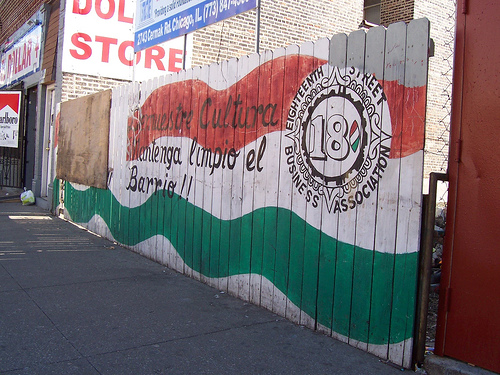
A mural on 18th Street in Chicago requests of passerby "Mantenga limpio el barrio," keep the neighborhood clean. Due to chain migration, this neighborhood has attracted a major cluster of Mexican residents -- but the neighborhood's name, Pilsen, records the earlier settlement of mostly Czech immigrants.
photo from Flickr/Paco Seoane
People on the Move [link]
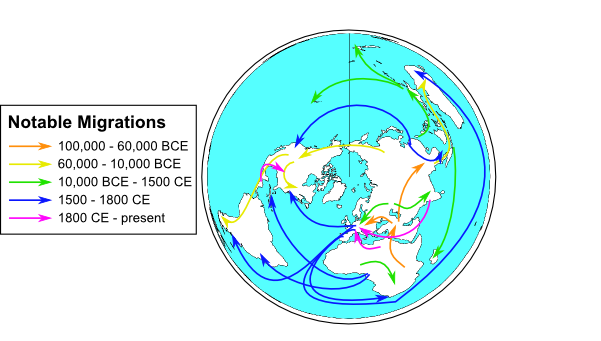
Figure 1: Notable inter-regional migrations. Migrations shown: Homo erectus and Homo sapiens leave Africa (100,000 BCE for H. sapiens); Australo-Melanesians move into Southeast Asia and Australia (60,000 - 40,000 BCE); Native Americans cross into the Americas (25,000 - 15,000 BCE); Indo-Europeans expand into Europe and South Asia (3000 - 1000 BCE); Polynesian voyages (3000 BCE - 1200 CE); Bantu expansion in Africa (1000 BCE - 500 AD); Malagasy colonize Madagascar (300 BCE - 500 CE); Atlantic slave trade (1400 - 1800 CE); European colonization of the Americas, South Africa, and Down Under (1500 - 1900 CE); East Asian diaspora to Southeast Asia and the Americas (1800 - 1950 CE); Latin American migration to North America (1900 CE - present); African, Middle Eastern, and South Asian migration to Europe (1950 CE - present).
People are constantly moving through space. Migration varies from temporary relocation (often for work or schooling) to a permanent uprooting of connections to their old home and putting down roots in their new one. Geographers often only apply the label "migration" to more permanent and long-distance moves, but such migration is just one end of a spectrum of human movement through space.
Extensive human migration has a long history. Our species, Homo sapiens, evolved in East Africa about 200,000 years ago. The earliest modern human fossils found outside of Africa are about 100,000 years old. The descendants of these first pioneers continued to spread through the world, reaching Australia by 60 to 50 thousand years ago, Europe by 40 thousand years ago, and the Americas by 20 to 15 thousand years ago. The last major landmass to be populated was New Zealand, which was reached at the end of the Polynesian migrations in about 1280 CE (Figure 1).
Once humans arrived in a new place, they did not stay put. At a broad scale, massive migrations such as the Bantu expansion in Africa or the waves of people moving out of the steppes of Central Asia continued to alter the genetic and cultural makeup of areas. These movements could be driven by a variety of political, ideological, economic, or environmental factors. At a more local scale, subsistence systems often required movement over the course of the year or several years. There is a common misconception that non-agricultural societies wander aimlessly or opportunistically over the land. In fact, hunter-gatherers and animal herders usually have well-defined yearly rounds, accessing a series of resources that become available in different ecological zones at different times.
A variety of factors may influence a person's decision about whether, where, and how to migrate. We commonly summarize these as push factors and pull factors (Figure 2) (Lee 1966). Push factors are things that make someone want to leave their current location. Economic troubles, persecution, war or other violence, and environmental crises are all common push factors. Pull factors are things that make a particular destination attractive. Economic opportunities, political freedom, and cultural or ideological significance (such as the importance of the land of Israel to Jews) may constitute important pull factors.
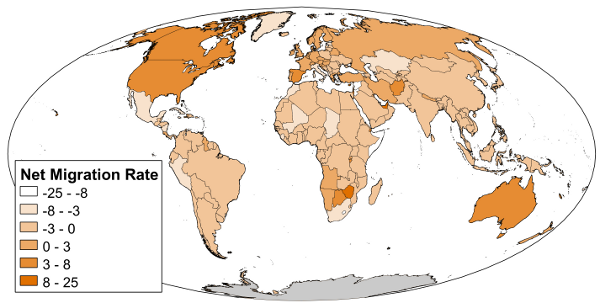
Figure 2: Net migration rate (migrants per 1,000 population), 2010. Countries with negative net migration rates are losing population to migration (more emigrants than immigrants), countries with positive net migration rates are gaining population (more immigrants than emigrants).
data from CIA World Factbook
Depending on the strength of the push and pull factors, migrants may have more or less choice about where to move. At one extreme, the African slave trade gave its victims no choice about whether to leave and where to go. At the other extreme, a high-ranking executive in a multinational corporation may have a great deal of discretion about whether to accept an offer to transfer from the New York office to the London or Dubai branch.
In addition to the push and pull factors, migrants also face barriers to their movement that alter their calculations about how to migrate (Lee 1966). Sometimes these barriers may be physical -- such as an ocean or a desert. Other times they are the result of social policy. For example, since 1993, the United States has massively expanded its security measures on the southern border, such as the number of Border Patrol agents, the scrutiny of passports and visas, and the building of fences and walls. This tightening security did not, as US policymakers had hoped, reduce the number of people who tried to cross the border. Instead, it had two main effects. First, it pushed people toward more dangerous crossings through the remote Arizona desert. Second, it encouraged migrants to the US to become more permanent. In the past, many Mexicans would come to the US to work for short periods of time, returning home to their families in Mexico in the off season. But as it became more difficult and more expensive to cross the border -- especially for those without legal status -- increasing numbers of Mexican migrants have decided to stay in the US for years or decades at a stretch rather than risk problems trying to cross the border. In some cases these more permanent migrants have ended up settling down in the US for good as they developed social and family connections in their new home and became acclimated to US culture (Massey 2008).
The balance of push factors, pull factors, and barriers may significantly shape the composition of the migrant population. One important factor is gender. If the opportunities that are available are mostly in female-dominated industries, the migration flow will be predominantly female. This is the case for migration from the Philippines to Canada, as most of the jobs available to Filipinos in Canada are as nurses and personal care workers. On the other hand, Mexicans coming to the US mostly work in male-dominated fields such as construction. Women coming to the US from Mexico also face special barriers with respect to child care and sexual assault. Since child care is traditionally a woman's responsibility, female would-be migrants face extra complications in arranging for their children to migrate or stay home. And they face a risk of sexual assault and rape from human smugglers (if they cross illegally) and/or Border Patrol agents (if they are caught) (Sheridan 2009).
Migration is not typically an individualized decision, undertaken by a person in isolation from their other social relationships. One common form that migration takes is chain migration. Chain migration occurs when migrants follow in the footsteps of people in their social network, such as family members, who have migrated before them. If chain migration is heavy enough, entire villages in the sender country may effectively be transplanted to the receiver country. Chain migration occurs because migrants make use of their social networks to ease the transition to a new place. A cousin who has already made the journey can send back information about opportunities in the receiver country and the potential hurdles in making the journey. Once the new migrant arrives, it is easier to get settled in, to understand the customs of the new place, and to find work if they already know people in the place they settle (Sheridan 2009).
Migrant Status [link]
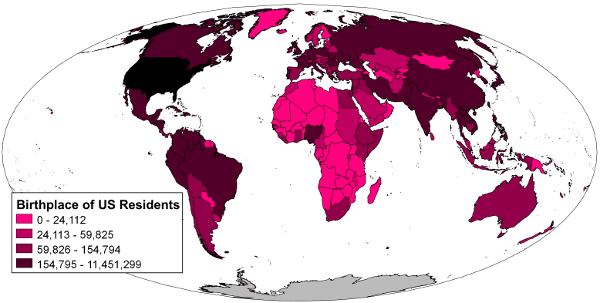
Figure 3: Countries of origin for US residents, 2008. Map shows number of US residents in 2008 born in that country.
data from Pew Hispanic Center tabulation of 2008 American Community Survey
Just because someone has been physically transported to a new location doesn't mean they end up a full-fledged resident of the new location. Moving from one state to another within the United States is fairly easy -- when I moved from Pennsylvania to Arizona, for example, a trip to the Motor Vehicle Division took care of most of the necessary changes (e.g. getting a new driver's license and registering to vote). But people who migrate to the US from another country can end up with a variety of migration statuses under the law (Congressional Budget Office 2006), which impart certain privileges and duties, and may significantly shape how people live their lives. While the specific list of statuses in this section is based on US immigration law, the basic ideas apply to most countries in the world. Figure 3 shows where foreign-born residents of the US were born, while Figure 4 shows a breakdown of the US population in 2008 by migration status.
The highest level of status is a citizen. Citizens are full members of the national community, with the right to vote, to receive all benefits from government programs (e.g. food stamps), and to serve on juries. US citizenship can be acquired through being born in the territory of the US (regardless of the status of one's parents), or by being born to US citizen parents in another country. People with certain other immigration statuses can also naturalize, taking a test and swearing an oath to become US citizens. Because citizens belong to the US, they cannot be deported. Citizenship can only be lost if you renounce it yourself to become a citizen of another country.
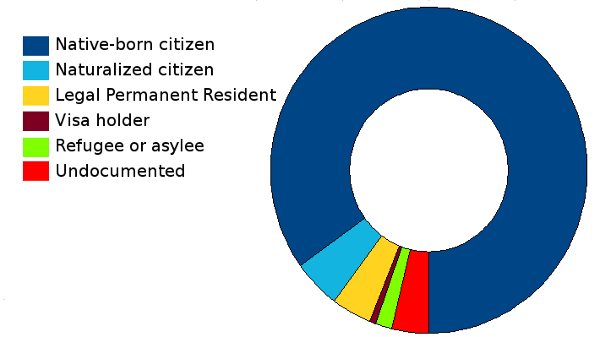
Figure 4: Migration status of US residents, 2008.
data from U.S. Department of Homeland Security and U.S. Census Current Population Survey
The next highest level of status is Legal Permanent Resident (LPR). As the name suggests, an LPR has the right to remain in the US for as long as they want, provided they don't break other immigration rules. LPRs are sometimes referred to as "green card holders," although the LPR identity document is no longer green in color. LPRs do not have some of the privileges of citizens -- for example, they are not permitted to vote. LPRs are also subject to deportation if they commit certain crimes. An LPR convicted of possession of cocaine, for example, would serve the usual jail sentence that a citizen would serve. Once they are released from prison, they may be taken to immigration court, where Immigration and Customs Enforcement would attempt to deport them back to their home country.
Permission to be in the country for a limited amount of time is granted by a visa. When a visa expires, the visa-holder must either apply for a new visa, adjust their status to something more permanent like LPR, or go home. There are a huge variety of visas for different sorts of people -- diplomatic visas, student visas, worker visas, tourist visas, athlete and entertainer visas, visas for victims of crimes, etc. Each type of visa has different conditions placed on it -- for example, only certain visas allow their holders to get a paid job. Like LPRs, visa holders may have their status revoked if they commit crimes.
People who are allowed into the country because it is dangerous for them to remain in their home country are called refugees (if their status is granted before they reach the US) or asylees (if they declare their intentions after they arrive at the US). In order to be granted refuge or asylum, a person needs to show that they face a risk of persecution on the basis of their religion, ethnicity, political views, or other membership in a particular social group. They must also show that this persecution is being conducted by, or cannot be stopped by, the government of the country. This means, for example, that a Christian from Iran could claim asylum because the government of Iran oppresses non-Muslims. But a Colombian who fears being caught in the crossfire of the guerilla war being carried out in that country by FARC rebels could not claim asylum, because they are not being targeted by the government on the basis of their ethnicity, political views, or any other particular characteristic.
A person who is present in the country without official immigration status is referred to as an undocumented, unauthorized, or illegal immigrant. While there are a limited number of opportunities for undocumented people to achieve some legal status, most have no options but to be deported if they are caught by Immigration and Customs Enforcement. The most common image of an undocumented immigrant is a person who crosses the border illegally. But in the United States approximately half of the undocumented population entered the country legally, for example on a student visa. They became undocumented because they stayed in the country when they should have left, for example staying after their visa expired.
Effects on Receiver Countries [link]
Migrants do not always receive a warm welcome in their new home. How they are accepted depends on a host of factors, including how they arrived in the country, why they came, and what country they came from. Nativism is a term referring to opposition to immigration. Nativists have a variety of reasons for opposing high levels of immigration.
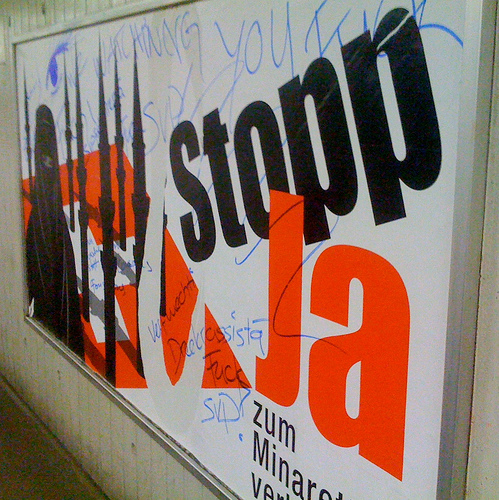
Figure 5: Poster in support of Swiss minaret ban. This poster was part of a successful campaign in 2009 to pass a constitutional amendment in Switzerland banning the construction of minarets. Supporters of the ban saw it as necessary to protect Swiss culture -- and the Swiss cultural landscape -- against alteration by Muslim immigrants. Opponents, who defaced this poster, saw the ban effort as religious discrimination motivated by racism.
photo from Flickr/ario_
Cultural clashes between immigrants and natives are a major source of nativism (Figure 5). While some natives enjoy living surrounded by cultural diversity, others resent having to share their country with people who have a significantly different way of life. In France, for example, there is a high level of conflict over the increasing number of immigrant and immigrant-descended women wearing hijab, a type of head covering common among devout Muslims. To many native French people, hijab is a symbol of the oppression of women and serves to bring religion into the secular public sphere, both of which clash with traditional French values. Language is often a major source of friction between immigrants and nativists -- for example, as of mid-2010 there were nearly a million members of the Facebook group "I'm in America, I shouldn't have to Press 1 for English," expressing resentment that the growing number of Spanish-speaking customers has led businesses to start their automated phone systems with a request to choose a language. Sociologists have documented that immigrants to the US usually take three generations to linguistically assimilate. The first generation (those who were born abroad and crossed the border) remain most comfortable in their original language and in some cases never manage to learn English. Their children are typically fully bilingual, speaking the old language at home and English in public areas. The third generation grows up speaking English and may have difficulty with, or never learn, their grandparents' original tongue. This pattern holds true for all waves of immigration to the US, including the current one from Latin America (Citrin et al. 2007).
The economic effects of immigration on receiver countries are contentious. One important source of nativism is the perception that immigrants are taking jobs that could otherwise go to natives. On the other hand, the increased population may boost the overall economy (since the immigrants have to buy food, cars, etc), ultimately creating more jobs. Attempts to calculate the balance between these factors for immigration to the US have generally concluded that migrants have an overall small positive effect on the overall economy and on the economic fortunes of most natives, though they do exert some downward economic pressure on the very poorest natives (e.g. high school dropouts) (Hanson 2009). A complicating factor here is the ability of employers to exploit undocumented immigrants, who can't complain about poor wages and unsafe working conditions without risking deportation. This exploitation harms native workers who would otherwise compete for those jobs, while helping everyone else by lowering the cost of production of the things they buy (e.g. cheap vegetables picked by underpaid migrant workers).
Further, immigrants have been calculated to be a net boon to public finances in the United States. Immigrants typically pay all of the same taxes (income tax, social security, property tax, sales tax) as citizens. Even undocumented immigrants may pay all of these taxes, either because they are working "on the books" with false papers, or because they hope a record of having paid their taxes will aid them in acquiring legal status. Meanwhile, immigrants are ineligible for many government services such as Social Security benefits (though they do take advantage of things like roads and emergency room care). Thus, calculations of immigrants' overall impact on government budgets have come out modestly positive (Council of Economic Advisers 2007). Nevertheless, the gains and losses from immigration may be unevenly distributed over space, with immigration placing higher burdens on public services in some places while the fiscal benefits of their presence flow elsewhere.
Nativists also sometimes point to concerns with crime. Because migrants are culturally disruptive, and many have arrived illegally, and may have come from a high-crime country, it is easy to imagine that they are responsible for a high rate of crime. In fact, however, studies have shown that immigrants in the US are less likely than natives to commit crimes (Rumbaut et al. 2006). On the other hand, immigrants (especially undocumented immigrants) are more likely to be victims of crime, from kidnapping by human smugglers, to exploitation by employers, to robbery and domestic violence. Perpetrators know that victims will be afraid to call the police for fear of being put into deportation proceedings (Estrada 2010).
Finally, in recent years nativists have begun emphasizing the possible environmental impacts of immigration. Echoing some neo-Malthusian concerns, these nativists argue that adding more people will over-strain the receiver country's natural resources. This is particularly so if the receiver country has a higher material standard of living -- a person living a typical US lifestyle will put a higher burden on the environment than one living a typical Mexican lifestyle. Research has struggled to establish clear parameters for the scope of the environmental impact of migration (Kraly 1995), and the effects are likely to depend on the particular sender and receiver places.
Effects on Sender Countries [link]
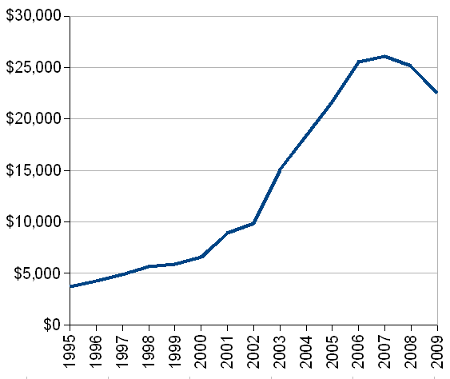
Figure 6: Remittances from US to Mexico. (vertical scale in millions of US dollars)
data from Banco de México
In addition to its effects on the receiver country, migration can have significant consequences for the sender country. One of the most notable of these is remittances. Remittances are money that migrants send home to their friends and family in their country of origin (Zárate-Hoyos 2005). Remittances occur because migrants rarely leave their old social networks behind when they migrate. Indeed, a whole village may pool its resources in order to pay for transportation, visa processing fees, and/or a smuggler's fee in order to get one person from the village into another country. Once in that new country, the migrant can earn a far higher wage than in their country of origin. By living cheaply, they can save up money and send it home to those who sponsored their journey, or to other family members in need. Remittances make up a major portion of many poor countries' foreign income -- for example, they are the second biggest source of foreign income (after oil) for Mexico. Figure 6 shows the level of remittances from the US to Mexico in recent years. Globally, remittances far exceed the money given to poorer countries through formal aid programs.
When remittances are received, they may be spent in various ways. Sometimes they merely contribute to the upkeep of receivers who are unable to work or can't find a job. Other times they are invested in economic development projects. For example, one village in Mexico used the remittances it received from the US to finance a plant to produce pickled cactus. Their hope was that if the plant succeeded, it would provide local jobs and eliminate the need for young men in the village to migrate to the US (Boudreaux 2006).
Works Cited [link]
Boudreaux, Richard. 2006. The Seeds of Promise. Los Angeles Times, April 16.
Citrin, J., A. Lerman, M. Murakami, and K. Pearson. 2007. Testing Huntington: is Hispanic immigration a threat to American identity? Perspectives on Politics 5(1): 31-48.
Congressional Budget Office. 2006. Immigration Policy in the United States.
Council of Economic Advisers. 2007. Immigration's Economic Impact. Washington DC: The White House.
Estrada, Tony. 2010. Statement of Santa Cruz County Sheriff in support of suit against SB 1070. Tucson Citizen, July 6
Hanson, Gordon H. 2009. The Economics and Policy of Illegal Immigration in the United States. Washington DC: Migration Policy Institute.
Kraly, Ellen P. 1995. U.S. Immigration and the Environment: Scientific Research and Analytic Issues. U.S. Commission on Immigration Reform.
Lee, Everette. 1966. A theory of migration. Demography 3: 44-57.
Massey, Douglas S. 2008. Borderline madness: America's counterproductive immigration policy. In Debating Immigration, ed. Carol M. Swain, 129-138. New York: Cambridge University Press.
Rumbaut, Rubén G., Roberto G. Gonzales, Golnaz Komaie, and Charlie V. Morgan. 2006. Debunking the Myth of Immigrant Criminality: Imprisonment Among First- and Second-Generation Young Men. Washington DC: Migration Policy Institute.
Sheridan, Lynnaire M. 2009. "I Know It's Dangerous": Why Mexicans Risk Their Lives to Cross the Border. Tucson: University of Arizona Press.
Zárate-Hoyos, Germán A. 2005. The development impact of migrant remittances in Mexico, in Beyond Small Change: Making Migrant Remittances Count, ed. D. F. Terry and S. R. Wilson, 159-191. Washington: Inter-American Development Bank.